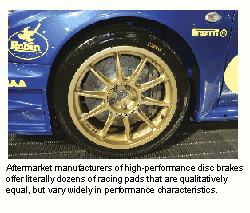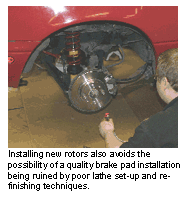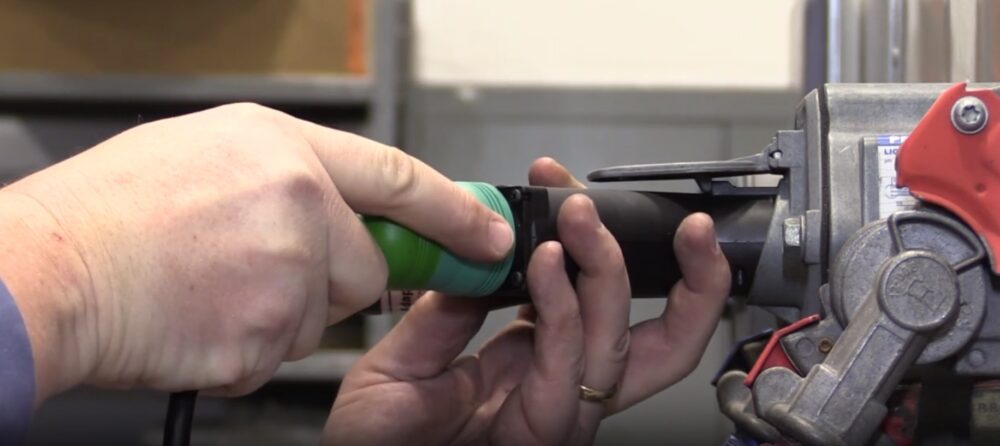Because today’s lighter and more friction-efficient disc brakes have become very sensitive to differences in friction materials, the issue of selecting a quality brake pad is becoming increasingly relevant to the quality-conscious installer.
To illustrate, aftermarket manufacturers of high-performance disc brakes offer literally dozens of racing pads that are qualitatively equal, but vary widely in performance characteristics. A set of “pavement” racing pads may deliver maximum braking power and good pedal response only when they reach high operating temperatures. A set of “dirt” pads, on the other hand, must perform to the same standards while operating at significantly lower temperatures. Less obvious, the main difference between the two types of pads is simply the amount of axle torque each must deal with during an extended braking cycle.
 The same types of performance issues can exist in the application-specific import pad market. So whether installers choose OE or aftermarket friction materials, it’s important to remember that the performance of even the best disc brake pad can be compromised by poor disc brake rotor and caliper preparation.
The same types of performance issues can exist in the application-specific import pad market. So whether installers choose OE or aftermarket friction materials, it’s important to remember that the performance of even the best disc brake pad can be compromised by poor disc brake rotor and caliper preparation.
SURFACE FINISHING
Because it’s designed to be compatible with a variety of disc pad friction materials, a brand-new, out-of-the-box disc brake rotor is usually supplied with a very smooth, mirror-like finish. In the days when asbestos was the sole material used in brake pads, many experts felt that a slightly rough, non-directional surface finish actually helped the pads seat to the rotor. Today, however, we are seeing a diverse number of friction material compositions ranging from ceramic in premium friction grades to the so-called “organic” materials used in less expensive friction grades.
When a rotor is refinished, the lathe usually leaves a microscopic “phonograph” groove that spirals from the center to the edge. No matter how sharp, the cutting bit often leaves sharp, microscopic ridges of metal protruding along the edges of the groove. This condition can be aggravated by wear in the drive mechanism of the lathe and/or incorrect mounting of the cutting bits, which results in a “wood-grain” finish defect on the rotor surface.
Unfortunately, when modern brake pad lining materials are installed on torn metal surfaces, metal-to-metal noises such as a mild initial engagement chirps, humidity and temperature sensitive squeals develop because small particles of metal embed themselves in the brake pad itself. In most cases, these noise complaints can be remedied only by re-machining a smooth surface on the rotor and installing a new set of brake pads.
The key point of any surface refinishing procedure is to minimize the effects of the spiral lathe cut and to remove jagged metal that might embed in the friction lining. To ensure the smoothest surface possible, the “phonograph record” effect can be minimized by using a light final cut of, let’s say, 0.002 inches per side, at the lathe’s minimum feed rate. Next, residual torn metal can be removed by using a variety of rotor surface refinishing discs and pads available for that purpose. Last, it’s extremely important to wash the rotor in a soap-and-water until metallic dust can no longer be detected by wiping a white shop towel across the rotor’s surface.
BASIC LATHE SET-UPS
Measuring rotor run-out on the vehicle is difficult for even the best technicians because of the slight amount of endplay existing in most hub assemblies. Some import shops go through an elaborate process of reducing rotor run-out by “indexing” the rotor to the hub assembly. Other shops eliminate this step altogether by using on-car rotor refinishing equipment to cut the rotor exactly perpendicular to the rotational axis of the wheel.
 Achieving zero run-out during the machining and mounting process is important because excessive run-out in a brake rotor will cause the rotor to rub against the new set of brake pads. This rubbing effect will eventually spot-wear the rotor surfaces enough to cause differences in parallelism between the inner and outer surfaces of the rotor. To illustrate the critical difference between run-out and parallelism, a variation of 0.005” in the run-out of a brake rotor won’t, in most cases, cause a perceptible pedal pulsation issue. In direct contrast, a variation in the parallelism of the rotor of as little as 0.0005” will cause a pedal pulsation complaint, even under mild braking conditions.
Achieving zero run-out during the machining and mounting process is important because excessive run-out in a brake rotor will cause the rotor to rub against the new set of brake pads. This rubbing effect will eventually spot-wear the rotor surfaces enough to cause differences in parallelism between the inner and outer surfaces of the rotor. To illustrate the critical difference between run-out and parallelism, a variation of 0.005” in the run-out of a brake rotor won’t, in most cases, cause a perceptible pedal pulsation issue. In direct contrast, a variation in the parallelism of the rotor of as little as 0.0005” will cause a pedal pulsation complaint, even under mild braking conditions.
The key issue in resurfacing any rotor to accept a quality brake pad is to use a brake lathe with an accurate arbor supported by tight, zero-tolerance bearings. The mounting fixtures must also be free of dirt, grease, dings and other blemishes that may ruin the accuracy of the set-up procedure.
Remember that even a small particle of dirty grease on a mounting fixture can translate into several thousandths run-out at the edge of the brake rotor. Even with the best set-up, the operator should attempt to compensate for slight tolerance variations in the lathe set-up by turning the rotor in the mounting fixture until a maximum amount of cutting bit contact is achieved at the rotor surface.
SELLING NEW BRAKE ROTORS
Since some modern brake rotors aren’t made with enough stock for other than minor resurfacing, more import shops are choosing to estimate and install new rotors as part of their recommended disc pad installation procedure. Aside from new rotors being less prone to heat distortion by having more mass to absorb heat, installing new rotors also avoids the possibility of a quality brake pad installation being ruined by poor lathe set-up and refinishing techniques.
One cautionary note should, however, be observed when selecting new brake rotors: Not all brake rotors are compatible with modern brake pad materials. Some “off-shore” rotors may be manufactured with inferior grades of cast iron that can initiate brake squeal and other noise complaints. As with any brake component, new brake rotors must be made from quality materials in order to ensure like-new performance.
THE ROLE OF BRAKE CALIPERS
The caliper’s job is to hold the new brake pads in alignment with the rotor and to smoothly apply and release pressure in response to the driver applying and releasing pressure at the brake pedal. When a caliper piston sticks inside the caliper bore or when the caliper guides become worn, poorly lubricated or corroded, the ability of the caliper to align the pads and to control pressure on the brake pad becomes drastically diminished.
Here again lies the difference between preparing for a quality brake pad installation or a shortcut, run-of-the-mill brake “job.” Caliper service should include checking for smooth piston retraction, inspecting caliper piston boots for tears, correctly lubing guides for re-assembly, and making sure all mounting hardware including anti-rattle clips and brake pad shims are correctly installed. Last, for safety’s sake, it’s always important to torque all caliper fasteners and wheel lug nuts to specification.
PAD SELECTION
When selecting brake pads, keep in mind that a savings of $10 on brake pads on a $200 brake service amounts to a savings of only 5 percent for the customer. While 5 percent might seem like a “big number” from a marketing standpoint, it will hardly pay for the comebacks caused by using a poor-performing brake pad or pad installation.
Most pad-related customer complaints usually fall into four categories: 1) noise; 2) pedal response; 3) service life; and 4) overall braking performance. Most owners hate annoying temperature and humidity sensitive brake squeaks and chirps.
Next, since most braking situations fall under the mild to moderate category, pedal feel and response are very important. Service life, on the other hand, is a primary factor if the vehicle is driven in a commercial or high-annual-mileage situation. Service life may also be coupled with braking performance, especially with trucks and SUVs used in towing or load-hauling situations.
Last, overall braking performance, which includes stopping power and resistance to heat fade, isn’t normally a consideration in the consumer market. It does become a consideration, however, if the vehicle is driven in mountainous areas or subjected to high-speed driving conditions such as police or emergency vehicle use.
In any case, real-world experience is the best evaluator of pad performance. By observing how various pad materials perform in different vehicle applications and operating situations and by communicating with your friction supplier, you can recommend the best pad for the application. As with any technical endeavor, product-specific knowledge is a characteristic that separates the amateur from the true automotive service professional.


